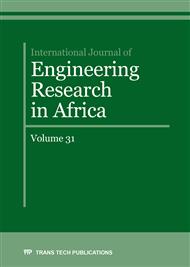[1]
ICT Investiment Profile, Zambia ICT Agency (ZICTA) and Zambia Development Agency (ZDA), Lusaka, (2015).
Google Scholar
[2]
S. Habeenzu, Telecommunications Regulatory Environment in Zambia ICT Sector Performance Review, Lusaka, (2010).
Google Scholar
[3]
Abdullateef, A. N. Hashim and B. D. Sarkindaji, A Review of the Inconsistency in CRM Measurement: Evidence from the Telecommunication Industry, Journal of International Business and Economics, vol. 2, no. 2, pp.107-131, (2014).
Google Scholar
[4]
A. Almana, et al, A Survey On Data Mining Techniques In Customer Churn Analysis For Telecom Industry, International Journal of Engineering Research and Applications, vol. 4, no. 5, pp.165-171, (2014).
Google Scholar
[5]
Federal Communications Commission, 17th Report - Annual Report and Analysis of Competitive Market Conditions With Respect to Mobile Wireless, Including Commercial Mobile Services, Federal Communications Commission;, Washington DC, (2014).
DOI: 10.1002/9781118907658.app4
Google Scholar
[6]
M. Aufar, 7th Asia-Pacific Business Research Conference, in Study of Post-Churn Impacts on Brand Image in Telecommunication Sector, Singapore, (2014).
Google Scholar
[7]
A. Kuusik and U. Varblane, How to avoid customers leaving: the case of the Estonian telecommunication industry, Baltic Journal of Management, vol. 4, no. 1, pp.66-79, (2009).
DOI: 10.1108/17465260910930458
Google Scholar
[8]
B. Oghojafor, Discriminant Analysis of Factors Affecting Telecoms Customer Churn, International Journal of Business Administration, vol. 3, no. 2, 15 March (2012).
DOI: 10.5430/ijba.v3n2p59
Google Scholar
[9]
D. Y. Arthur, E. Harris and J. Annan, Principal Component Analysis of Customer Churns in Ghanaian Telecommunication Industry, American International Journal of Contemporary Research, vol. 2, no. 12, (2012).
Google Scholar
[10]
Predicting Customer Churn in the Mobile Telecommunication Industry, A case study of MTN Ghana, Kumasi, (2011).
Google Scholar
[11]
A. Government, Achievements of the Ministry of Communication and Information Technology in 2010, Ministry of Communication and Information Technology, Afghanistan, (2011).
Google Scholar
[12]
BIPT, 2014 Annual Report, Telecommunications Belgian Institute of Postal Services, Belgium, (2014).
Google Scholar
[13]
Telecom Italia, ERG Project Team IP-Interconnection and NGN – Consultation document on IP interconnection.
Google Scholar
[14]
A. M. Hughes, Churn reduction in the telecom industry, Database Marketing Institute Limited, (2008).
Google Scholar
[15]
J. Ojasalo, Customer Relationship Longevity and Satisfaction Sources in Professional Services, The Journal of the Economic Society of Finland, (1999).
Google Scholar
[16]
R. Mattison, The Telco Churn Management Handbook, Illinois: XiT Press, (2005).
Google Scholar
[17]
A. Lemmens and S. Gupta, Managing Churn to Maximize Profits, Working Paper, vol. 14, no. 20, (2013).
Google Scholar
[18]
Ernst & Young, The Revised Revenue Reconginition Proposal: Telecommunications, EYGM Limited, (2012).
Google Scholar
[19]
A. A. Khan, M. M. Sepehri and S. Jamwal, Applying Data Mining to Customer Churn Prediction in an Internet Service Provider, International Journal of Computer Applications, vol. 9, no. 7, (2010).
DOI: 10.5120/1400-1889
Google Scholar
[20]
H.S. Kim and C.H. Yoon, Determinants of subscriber churn and customer loyalty in the Korean mobile telephony market, sciencedirect, Korea, (2004).
DOI: 10.1016/j.telpol.2004.05.013
Google Scholar
[21]
J. Chen and R. Ching, The Effects of Mobile Customer Relationship Management on Customer Loyalty, in Proceedings of the 40th Hawaii International Conference on System Sciences, Hawaii, (2007).
DOI: 10.1109/hicss.2007.526
Google Scholar
[22]
S. Rajasekar, Research Methodology, India: School of Physics, Bharathidasan University, (2014).
Google Scholar
[23]
J. Jonker and B. Pennink, The Essence of Research Methodology: A concise guide for Master and PhD students in Management Science, New york: Springer Heldelberg, (2010).
DOI: 10.1007/978-3-540-71659-4
Google Scholar
[24]
R. Khotari, Research Methodology Methods and Techniques, 2nd ed., New Dehli: New Age International Publishers, (2004).
Google Scholar
[25]
Government of the Republic of Zambia, 2010 Census of Population and Housing - Volume 11: National Descriptive Tables, Central Statistical Office, Lusaka, (2012).
Google Scholar
[26]
17th Report - Annual Report and Analysis of Competitive Market Conditions With Respect to Mobile Wireless, Including Commercial Mobile Services, Washington DC: Federal Communications Commission, (2014).
Google Scholar


